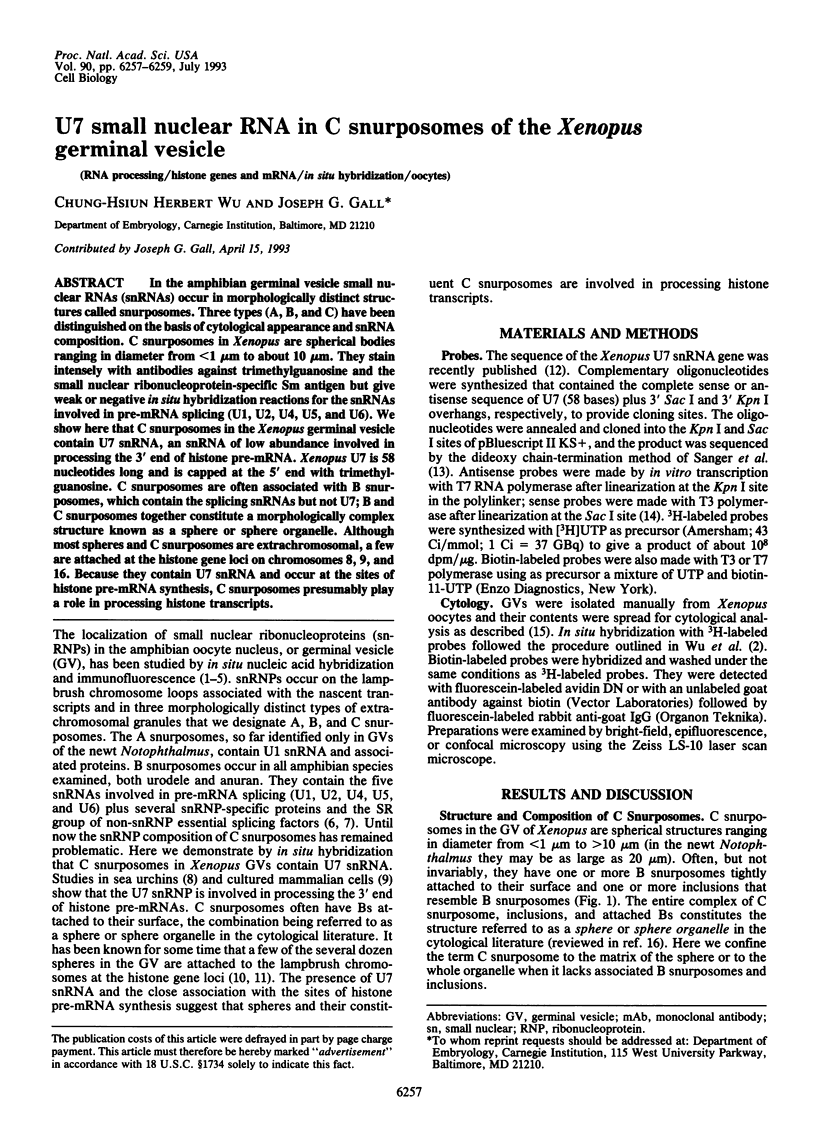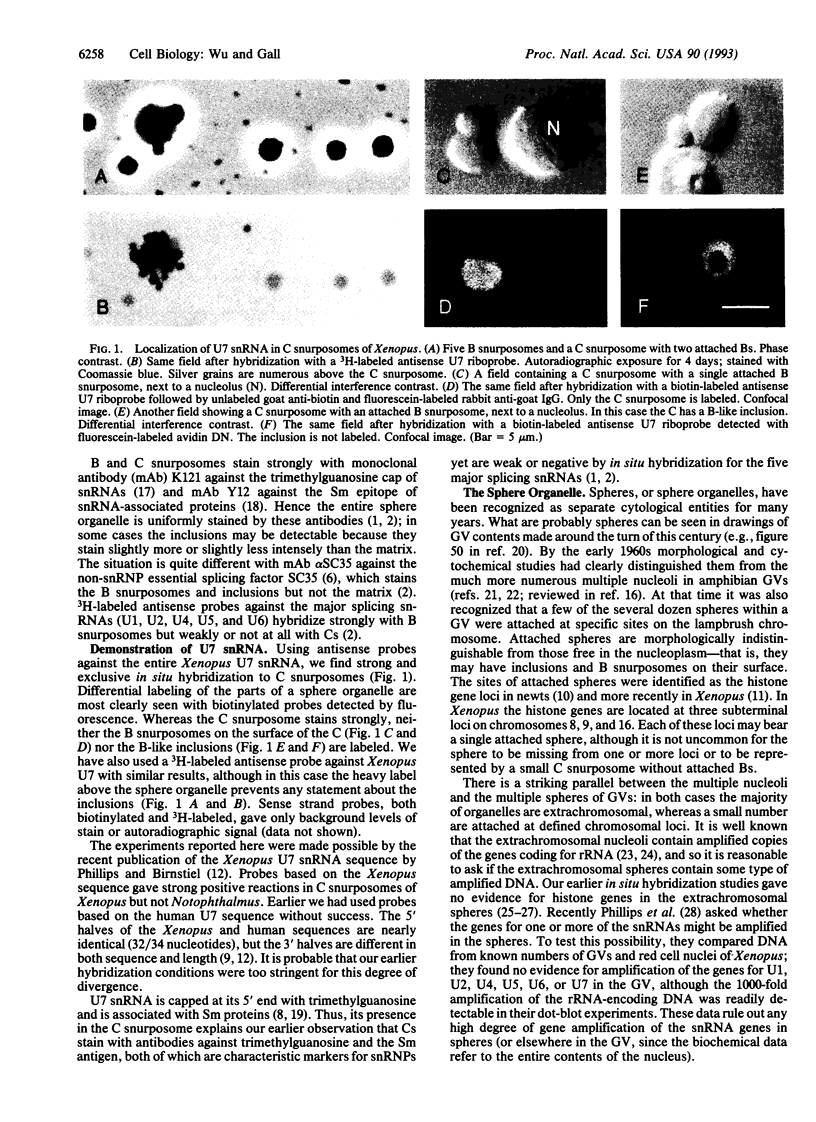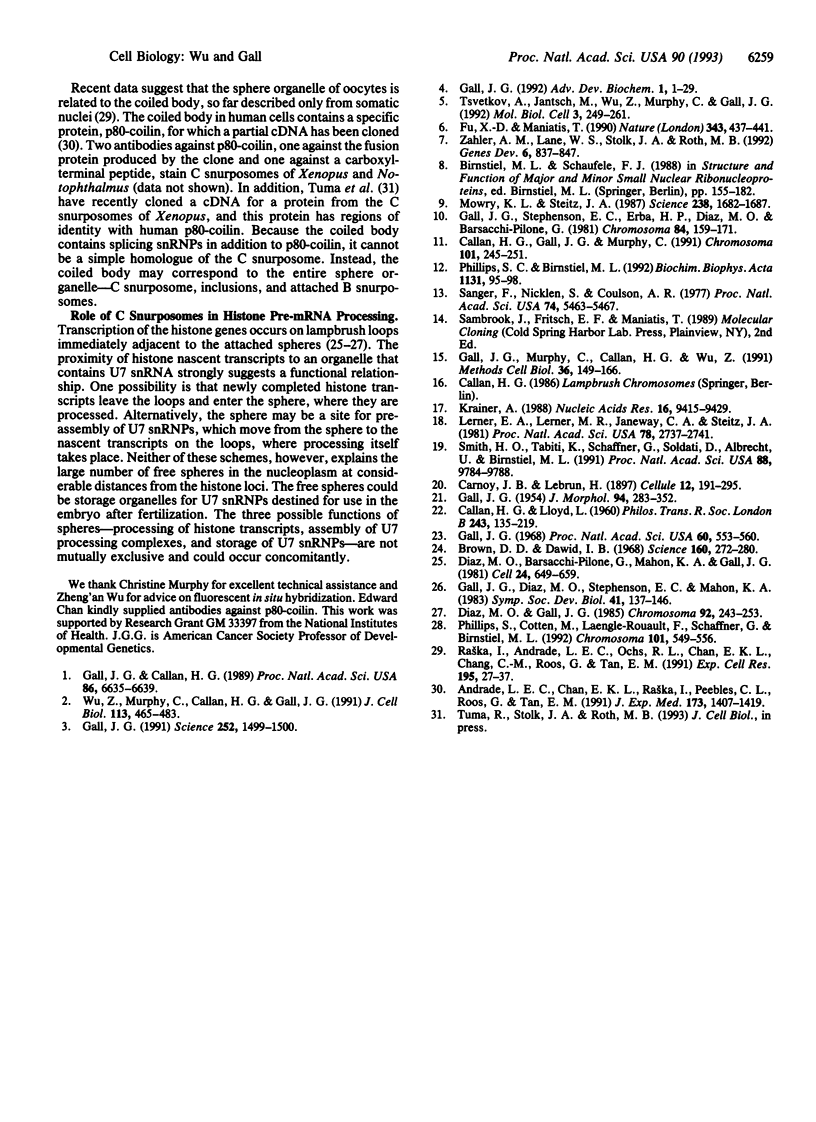Abstract
In the amphibian germinal vesicle small nuclear RNAs (snRNAs) occur in morphologically distinct structures called snurposomes. Three types (A, B, and C) have been distinguished on the basis of cytological appearance and snRNA composition. C snurposomes in Xenopus are spherical bodies ranging in diameter from < 1 microns to about 10 microns. They stain intensely with antibodies against trimethylguanosine and the small nuclear ribonucleoprotein-specific Sm antigen but give weak or negative in situ hybridization reactions for the snRNAs involved in pre-mRNA splicing (U1, U2, U4, U5, and U6). We show here that C snurposomes in the Xenopus germinal vesicle contain U7 snRNA, an snRNA of low abundance involved in processing the 3' end of histone pre-mRNA. Xenopus U7 is 58 nucleotides long and is capped at the 5' end with trimethylguanosine. C snurposomes are often associated with B snurposomes, which contain the splicing snRNAs but not U7; B and C snurposomes together constitute a morphologically complex structure known as a sphere or sphere organelle. Although most spheres and C snurposomes are extrachromosomal, a few are attached at the histone gene loci on chromosomes 8, 9, and 16. Because they contain U7 snRNA and occur at the sites of histone pre-mRNA synthesis, C snurposomes presumably play a role in processing histone transcripts.
Full text
PDF


Images in this article
Selected References
These references are in PubMed. This may not be the complete list of references from this article.
- Andrade L. E., Chan E. K., Raska I., Peebles C. L., Roos G., Tan E. M. Human autoantibody to a novel protein of the nuclear coiled body: immunological characterization and cDNA cloning of p80-coilin. J Exp Med. 1991 Jun 1;173(6):1407–1419. doi: 10.1084/jem.173.6.1407. [DOI] [PMC free article] [PubMed] [Google Scholar]
- Brown D. D., Dawid I. B. Specific gene amplification in oocytes. Oocyte nuclei contain extrachromosomal replicas of the genes for ribosomal RNA. Science. 1968 Apr 19;160(3825):272–280. doi: 10.1126/science.160.3825.272. [DOI] [PubMed] [Google Scholar]
- Callan H. G., Gall J. G., Murphy C. Histone genes are located at the sphere loci of Xenopus lampbrush chromosomes. Chromosoma. 1991 Dec;101(4):245–251. doi: 10.1007/BF00365156. [DOI] [PubMed] [Google Scholar]
- Diaz M. O., Barsacchi-Pilone G., Mahon K. A., Gall J. G. Transcripts from both strands of a satellite DNA occur on lampbrush chromosome loops of the newt Notophthalmus. Cell. 1981 Jun;24(3):649–659. doi: 10.1016/0092-8674(81)90091-x. [DOI] [PubMed] [Google Scholar]
- Diaz M. O., Gall J. G. Giant readthrough transcription units at the histone loci on lampbrush chromosomes of the newt Notophthalmus. Chromosoma. 1985;92(4):243–253. doi: 10.1007/BF00329807. [DOI] [PubMed] [Google Scholar]
- Fu X. D., Maniatis T. Factor required for mammalian spliceosome assembly is localized to discrete regions in the nucleus. Nature. 1990 Feb 1;343(6257):437–441. doi: 10.1038/343437a0. [DOI] [PubMed] [Google Scholar]
- Gall J. G., Callan H. G. The sphere organelle contains small nuclear ribonucleoproteins. Proc Natl Acad Sci U S A. 1989 Sep;86(17):6635–6639. doi: 10.1073/pnas.86.17.6635. [DOI] [PMC free article] [PubMed] [Google Scholar]
- Gall J. G. Differential synthesis of the genes for ribosomal RNA during amphibian oögenesis. Proc Natl Acad Sci U S A. 1968 Jun;60(2):553–560. doi: 10.1073/pnas.60.2.553. [DOI] [PMC free article] [PubMed] [Google Scholar]
- Gall J. G., Murphy C., Callan H. G., Wu Z. A. Lampbrush chromosomes. Methods Cell Biol. 1991;36:149–166. [PubMed] [Google Scholar]
- Gall J. G. Spliceosomes and snurposomes. Science. 1991 Jun 14;252(5012):1499–1500. doi: 10.1126/science.1828621. [DOI] [PubMed] [Google Scholar]
- Gall J. G., Stephenson E. C., Erba H. P., Diaz M. O., Barsacchi-Pilone G. Histone genes are located at the sphere loci of newt lampbrush chromosomes. Chromosoma. 1981;84(2):159–171. doi: 10.1007/BF00399128. [DOI] [PubMed] [Google Scholar]
- Krainer A. R. Pre-mRNA splicing by complementation with purified human U1, U2, U4/U6 and U5 snRNPs. Nucleic Acids Res. 1988 Oct 25;16(20):9415–9429. doi: 10.1093/nar/16.20.9415. [DOI] [PMC free article] [PubMed] [Google Scholar]
- Lerner E. A., Lerner M. R., Janeway C. A., Jr, Steitz J. A. Monoclonal antibodies to nucleic acid-containing cellular constituents: probes for molecular biology and autoimmune disease. Proc Natl Acad Sci U S A. 1981 May;78(5):2737–2741. doi: 10.1073/pnas.78.5.2737. [DOI] [PMC free article] [PubMed] [Google Scholar]
- Mowry K. L., Steitz J. A. Identification of the human U7 snRNP as one of several factors involved in the 3' end maturation of histone premessenger RNA's. Science. 1987 Dec 18;238(4834):1682–1687. doi: 10.1126/science.2825355. [DOI] [PubMed] [Google Scholar]
- Phillips S. C., Birnstiel M. L. Analysis of a gene cluster coding for the Xenopus laevis U7 snRNA. Biochim Biophys Acta. 1992 May 7;1131(1):95–98. doi: 10.1016/0167-4781(92)90104-8. [DOI] [PubMed] [Google Scholar]
- Phillips S., Cotten M., Laengle-Rouault F., Schaffner G., Birnstiel M. L. Amphibian oocytes and sphere organelles: are the U snRNA genes amplified? Chromosoma. 1992 Aug;101(9):549–556. doi: 10.1007/BF00660314. [DOI] [PubMed] [Google Scholar]
- Raska I., Andrade L. E., Ochs R. L., Chan E. K., Chang C. M., Roos G., Tan E. M. Immunological and ultrastructural studies of the nuclear coiled body with autoimmune antibodies. Exp Cell Res. 1991 Jul;195(1):27–37. doi: 10.1016/0014-4827(91)90496-h. [DOI] [PubMed] [Google Scholar]
- Sanger F., Nicklen S., Coulson A. R. DNA sequencing with chain-terminating inhibitors. Proc Natl Acad Sci U S A. 1977 Dec;74(12):5463–5467. doi: 10.1073/pnas.74.12.5463. [DOI] [PMC free article] [PubMed] [Google Scholar]
- Smith H. O., Tabiti K., Schaffner G., Soldati D., Albrecht U., Birnstiel M. L. Two-step affinity purification of U7 small nuclear ribonucleoprotein particles using complementary biotinylated 2'-O-methyl oligoribonucleotides. Proc Natl Acad Sci U S A. 1991 Nov 1;88(21):9784–9788. doi: 10.1073/pnas.88.21.9784. [DOI] [PMC free article] [PubMed] [Google Scholar]
- Tsvetkov A., Jantsch M., Wu Z., Murphy C., Gall J. G. Transcription on lampbrush chromosome loops in the absence of U2 snRNA. Mol Biol Cell. 1992 Mar;3(3):249–261. doi: 10.1091/mbc.3.3.249. [DOI] [PMC free article] [PubMed] [Google Scholar]
- Wu Z. A., Murphy C., Callan H. G., Gall J. G. Small nuclear ribonucleoproteins and heterogeneous nuclear ribonucleoproteins in the amphibian germinal vesicle: loops, spheres, and snurposomes. J Cell Biol. 1991 May;113(3):465–483. doi: 10.1083/jcb.113.3.465. [DOI] [PMC free article] [PubMed] [Google Scholar]
- Zahler A. M., Lane W. S., Stolk J. A., Roth M. B. SR proteins: a conserved family of pre-mRNA splicing factors. Genes Dev. 1992 May;6(5):837–847. doi: 10.1101/gad.6.5.837. [DOI] [PubMed] [Google Scholar]



